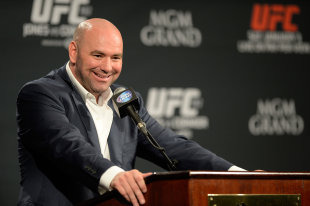LAS VEGAS – For years, there was a familiar ritual to fight weeks, particularly pay-per-view fight weeks, in the UFC.
Early in the week would be the Dana White video blog. White would run a news conference and field the majority of the questions.
When the news conference ended, White would hold a wide-ranging scrum with reporters.
White then would do television interviews and radio interviews day-after-day until fight night.
And it worked. White is a brilliant promoter.
But what that strategy did was to promote Dana White more than anything else.
White, the colorful and outspoken UFC president, has long held a policy of answering every question. And so if he were promoting UFC 196, as he is this week, he’d be willing to answer questions not only about that week’s events, but also about upcoming events, cities that could be on the UFC’s radar to host future shows and a wide-ranging list of topics.
But in the last year or so, there has been a noticeable switch. White is far less accessible to the media than he had been, and perhaps that’s a good thing for the fighters.
White’s absence has led to more of a focus on the fighters and the events of the current week than what was to come.
A welterweight bout between Conor McGregor and Nate Diaz headlines UFC 196 on Saturday at the MGM Grand Garden. A women’s bantamweight title fight between Holly Holm and Miesha Tate is the co-feature.
Even though the historical element of McGregor potentially becoming the first fighter in UFC history to hold titles in two weight classes simultaneously went by the boards last week when lightweight champion Rafael dos Anjos broke a foot and had to withdraw, the show still has a good chance to reach 1 million pay-per-view sales.
Though the figure is often tossed around, it is an enormous line to hit and very difficult to do in boxing, MMA and pro wrestling.
Much of the interest in UFC 196 is centered around McGregor, the promotion’s dynamic featherweight champion who, by talent and force of personality, has become one of the biggest stars in the sport.
McGregor, and ex-women’s bantamweight champion Ronda Rousey, would have become big-time stars regardless of how White was used to promote.
But with the spotlight off White and firmly on the fighters now, it enables a show to grow exponentially if the fighters can sell it.
White’s strategy for years was reminiscent of boxing promoter Don King’s, in that King promoted himself more than he ever promoted a fight. It was clearly King’s intention to do business that way. He tried to make himself a major public figure and felt that by doing so, he could sell shows on his own.
It probably wasn’t White’s intention to market himself, but the affect of his great media presence for nearly 15 years was to make himself a bigger star than any of his fighters.
And he’s still up there in that level. White, for instance, has 3.47 million followers on Twitter and 1.4 million on Instagram. McGregor has 1.2 million on Twitter and 3.5 million on Instagram. And Rousey has 2.2 million Twitter followers and 7.6 million on Instagram.
The UFC is a pay-per-view company, and pay-per-view requires stars. So any promotional model that takes away from star-building isn’t as effective as it could be.
If White answered questions at a news conference like he did so frequently in the past or did a scrum with reporters, he’d undoubtedly be asked about plans to stage a fight in Ireland, updates on UFC 200, thoughts on Anderson Silva’s loss to Michael Bisping, the loss of Benson Henderson and potentially others to Bellator, and the health of fighters who had surgery like Cain Velasquez and C.M. Punk.
While that increases brand awareness, it doesn't necessarily help a specific show.
Since White isn't doing that, the fighters on UFC 196 will be center stage at open workouts, where White won’t even appear, and at Ultimate Media day, where they’ll sit in front of placards bearing their names and photos and allow reporters to interview them as they choose.
It will keep more of the focus on the athletes in the current event. And given that fighter compensation is directly tied to how popular they become and things like ticket and pay-per-view sales, that’s only a positive.
White’s web series, “Dana White: Looking for a Fight,” has essentially replaced the old video blog he did, where he’d take viewers behind the scenes of UFC events both leading up to and after the card.
While it still affords White plenty of camera time, it has already proven to be an effective way to gain UFC newcomers some notoriety. Sage Northcutt, who was “discovered” in the pilot episode, has quickly developed a large following.
Mickey Gall, who called out C.M. Punk in Episode 1, isn’t quite as big as Northcutt, but certainly is vastly better known than he would have been otherwise.
Anything that can help increase the fighters’ compensation and make them more appealing to sponsors is a good thing.
White hasn’t gone away and still does plenty of promotion, but he’s simply not front and center as he used to be.
It’s either a sign of the UFC’s growth, where the ownership feels that the brand has been solidified to the point where it doesn’t need to be pushed exclusively any more, or an acknowledgement that the fighters are the stars of the show.
Either way, it’s a good thing.

































